计算机英语参考译文和练习答案(doc 78页)
《计算机英语(第版)》课后练习参考答案

《计算机英语(第4版)》练习参考答案Unit One: Computer and Computer ScienceUnit One/Section AI.Fill in the blanks with the information given in the text:1. Charles Babbage; Augusta Ada Byron2. input; output3. VLSI4. workstations; mainframes5. vacuum; transistors6. instructions; software7. digit; eight; byte8. microminiaturization; chipII.Translate the following terms or phrases from English into Chinese and vice versa:1. artificial intelligence 人工智能2. paper-tape reader 纸带阅读器3. optical computer 光计算机4. neural network 神经网络5. instruction set 指令集6. parallel processing 并行处理7. difference engine 差分机8. versatile logical element 通用逻辑元件9. silicon substrate 硅衬底10. vacuum tube 真空管11. 数据的存储与处理the storage and handling of data12. 超大规模集成电路very large-scale integrated circuit13. 中央处理器central processing unit14. 个人计算机personal computer15. 模拟计算机analogue computer16. 数字计算机digital computer17. 通用计算机general-purpose computer18. 处理器芯片processor chip19. 操作指令operating instructions20. 输入设备input deviceIII.Fill in each of the blanks with one of the words given in the following list, making changes if necessary:We can define a computer as a device that accepts input, processes data, stores data, and produces output. According to the mode of processing, computers are either analog or digital.They can also be classified as mainframes, minicomputers, workstations, or microcomputers.All else (for example, the age of the machine) being equal, this categorization provides some indication of the compu ter’s speed, size, cost, and abilities.Ever since the advent of computers, there have been constant changes. First-generation computers of historic significance, such as UNIVAC(通用自动计算机), introduced in the early 1950s, were based on vacuum tubes. Second-generation computers, appearing in the early 1960s, were those in which transistors replaced vacuum tubes. In third-generation computers, dating from the 1960s, integrated circuits replaced transistors. In fourth-generation computers such as microcomputers, which first appeared in the mid-1970s, large-scale integration enabled thousands of circuits to be incorporated on one chip. Fifth-generation computers are expected to combine very-large-scale integration with sophisticated approaches to computing, including artificial intelligence and true distributed processing.IV. Translate the following passage from English into Chinese:计算机将变得更加先进,也将变得更加容易使用。
《计算机英语》课后习题答案
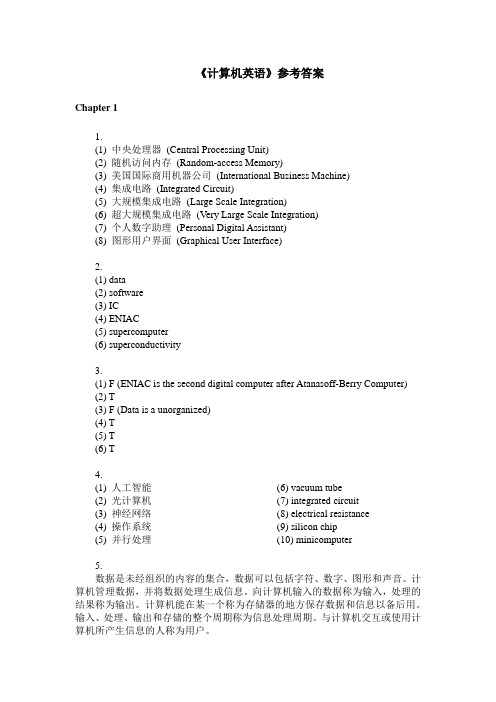
《计算机英语》参考答案Chapter 11.(1) 中央处理器(Central Processing Unit)(2) 随机访问内存(Random-access Memory)(3) 美国国际商用机器公司(International Business Machine)(4) 集成电路(Integrated Circuit)(5) 大规模集成电路(Large Scale Integration)(6) 超大规模集成电路(Very Large Scale Integration)(7) 个人数字助理(Personal Digital Assistant)(8) 图形用户界面(Graphical User Interface)2.(1) data(2) software(3) IC(4) ENIAC(5) supercomputer(6) superconductivity3.(1) F (ENIAC is the second digital computer after Atanasoff-Berry Computer)(2) T(3) F (Data is a unorganized)(4) T(5) T(6) T4.(1) 人工智能(2) 光计算机(3) 神经网络(4) 操作系统(5) 并行处理(6) vacuum tube(7) integrated circuit(8) electrical resistance(9) silicon chip(10) minicomputer5.数据是未经组织的内容的集合,数据可以包括字符、数字、图形和声音。
计算机管理数据,并将数据处理生成信息。
向计算机输入的数据称为输入,处理的结果称为输出。
计算机能在某一个称为存储器的地方保存数据和信息以备后用。
输入、处理、输出和存储的整个周期称为信息处理周期。
与计算机交互或使用计算机所产生信息的人称为用户。
1.(1) 发光二极管(Light-Emitting Diode)(2) 静态随机存储器(Static Random Access Memory)(3) 只读存储器(Read Only Memory)(4) 运算器(Arithmetic and Logical Unit)(5) 阴极射线管(Cathode Ray Tube)(6) 视频显示单元(Visual Display Unit)(7) 可编程只读存储器(Programmable Read Only Memory)(8) 液晶显示屏(Liquid Crystal Display)2.(1) CPU(2) peripheral(3) memory(4) modem(5) control unit(6) byte3.(1) T(2) T(3) F (RAM is volatile memory because the information within the computer chips is erased as soon as the computer is powered off whereas ROM is nonvolatile)(4) T(5) T(6) F (Microphones and digital cameras are input devices)4.(1) 寄存器组(2) 主机(3) 二进制的(4) 算法(5) 光盘(6) CD-RW(7) logic operation(8) barcode(9) peripheral device(10) volatile memory5.计算机的内存可被视为一系列的单元,可以在单元中存取数字。
计算机专业英语翻译及课后答案
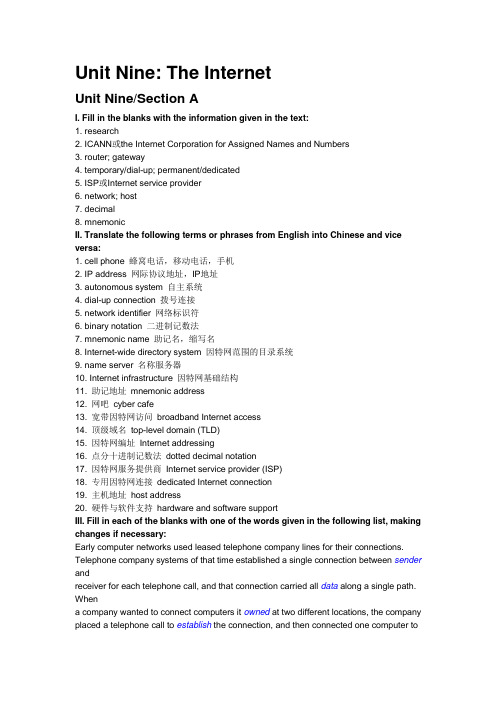
Unit Nine: The InternetUnit Nine/Section AI. Fill in the blanks with the information given in the text:1. research2. ICANN或the Internet Corporation for Assigned Names and Numbers3. router; gateway4. temporary/dial-up; permanent/dedicated5. ISP或Internet service provider6. network; host7. decimal8. mnemonicII. Translate the following terms or phrases from English into Chinese and vice versa:1. cell phone 蜂窝电话,移动电话,手机2. IP address 网际协议地址,IP地址3. autonomous system 自主系统4. dial-up connection 拨号连接5. network identifier 网络标识符6. binary notation 二进制记数法7. mnemonic name 助记名,缩写名8. Internet-wide directory system 因特网范围的目录系统9. name server 名称服务器10. Internet infrastructure 因特网基础结构11. 助记地址mnemonic address12. 网吧cyber cafe13. 宽带因特网访问broadband Internet access14. 顶级域名top-level domain (TLD)15. 因特网编址Internet addressing16. 点分十进制记数法dotted decimal notation17. 因特网服务提供商Internet service provider (ISP)18. 专用因特网连接dedicated Internet connection19. 主机地址host address20. 硬件与软件支持hardware and software supportIII. Fill in each of the blanks with one of the words given in the following list, making changes if necessary:Early computer networks used leased telephone company lines for their connections. Telephone company systems of that time established a single connection between sender andreceiver for each telephone call, and that connection carried all data along a single path. Whena company wanted to connect computers it owned at two different locations, the company placed a telephone call to establish the connection, and then connected one computer toeachend of that single connection.The U. S. Defense Department was concerned about the inherent risk of thissingle-channel method for connecting computers, and its researchers developed a differentmethod of sending information through multiple channels. In this method, files and messagesare broken into packets that are labeled electronically with codes for their origins, sequences,and destinations. In 1969, Defense Department researchers in the Advanced Research ProjectsAgency (ARPA) used this network model to connect four computers into a network called theARPANET. The ARPANET was the earliest of the networks that eventually combined to become what we now call the Internet. Throughout the 1970s and 1980s, many researchers inthe academic community connected to the ARPANET and contributed to the technological developments that increased its speed and efficiency.IV. Translate the following passage from English into Chinese:因特网只是提供了将许许多多的计算机连接在一起的物理与逻辑基础结构。
《计算机专业英语》习题参考答案
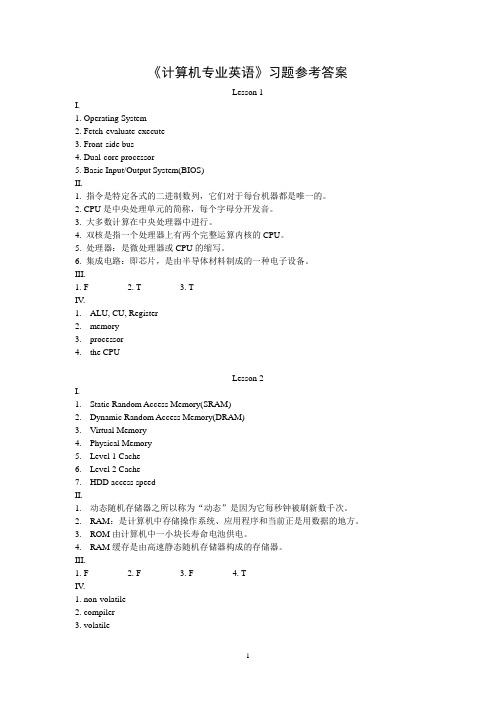
《计算机专业英语》习题参考答案Lesson 1I.1. Operating System2. Fetch-evaluate-execute3. Front-side bus4. Dual-core processor5. Basic Input/Output System(BIOS)II.1. 指令是特定各式的二进制数列,它们对于每台机器都是唯一的。
2. CPU是中央处理单元的简称,每个字母分开发音。
3. 大多数计算在中央处理器中进行。
4. 双核是指一个处理器上有两个完整运算内核的CPU。
5. 处理器:是微处理器或CPU的缩写。
6. 集成电路:即芯片,是由半导体材料制成的一种电子设备。
III.1. F2. T3. TIV.1.ALU, CU, Register2.memory3.processor4.the CPULesson 2I.1.Static Random Access Memory(SRAM)2.Dynamic Random Access Memory(DRAM)3.Virtual Memory4.Physical Memory5.Level 1 Cache6.Level 2 Cache7.HDD access speedII.1.动态随机存储器之所以称为“动态”是因为它每秒钟被刷新数千次。
2.RAM:是计算机中存储操作系统、应用程序和当前正是用数据的地方。
3.ROM由计算机中一小块长寿命电池供电。
4.RAM缓存是由高速静态随机存储器构成的存储器。
III.1. F2. F3. F4. TIV.1. non-volatile2. compiler3. volatile4. DRAMLesson 3I.1. Motherboard2. PC Case3. Hard Disk Drive(HDD)4. Optical mouse5. RAM6. Mobile DiskII.1.PC是有很多组件构成的一个系统。
《计算机专业英语》答案
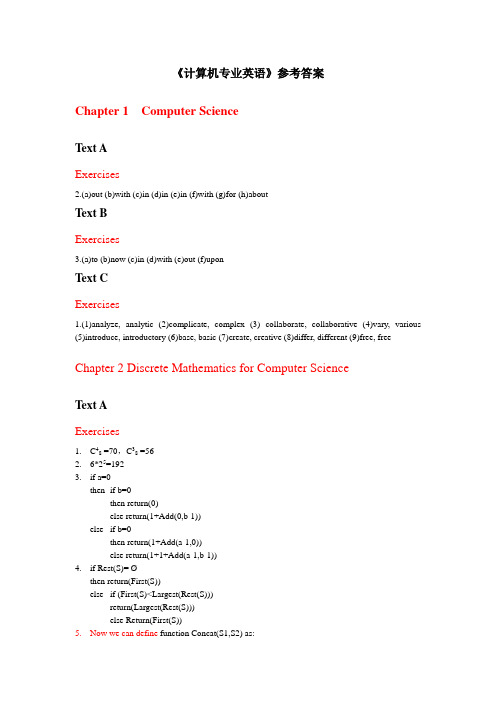
《计算机专业英语》参考答案Chapter 1 Computer ScienceText AExercises2.(a)out (b)with (c)in (d)in (e)in (f)with (g)for (h)aboutText BExercises3.(a)to (b)now (c)in (d)with (e)out (f)uponText CExercises1.(1)analyze, analytic (2)complicate, complex (3) collaborate, collaborative (4)vary, various (5)introduce, introductory (6)base, basic (7)create, creative (8)differ, different (9)free, freeChapter 2 Discrete Mathematics for Computer ScienceText AExercises1.C48 =70,C38 =562.6*25=1923.if a=0then i f b=0then return(0)else return(1+Add(0,b-1))else if b=0then return(1+Add(a-1,0))else return(1+1+Add(a-1,b-1))4.if Rest(S)=Øthen return(First(S))else if (First(S)<Largest(Rest(S)))return(Largest(Rest(S)))else Return(First(S))5.Now we can define function Concat(S1,S2) as:if(Length(S1)=0)then return(S2)else return(Cons(First(S1), Concat(Rest(S1),S2)))Text BExercises1.[Proof]:According to given conditions, we knowa n = a n-1 + 2na n-1 = a n-2 + 2(n-1)……a2 = a1 + 2*2a1 = 3sum all items in left side, and delete same items in the right side of equations, we can result thata n = 3 + 2(2+3+……+n-1+n)=1+n(n+1)=n2+n+1that is what we conclude.Text CExercises1.(1)depend, dependent (2) correspond, correspondent (3)grow, grown (4)solve, solvent (5) relate, relational (6)recur, recursive (7) validate, valid (8) conclude, conclusive (9) justify, justificative2.(1)connect-disconnect (2)possible-impossible (3)regular-irregular (4)measure-countermeasureChapter 3 Algorithms in the Real WorldText AExercises2. finite, solving, processing, effective, eventually, next, randomly3. by, in, on, in, on, from4. the algorithm can terminate.It is correct for sorting.If the length of array A is n, the time for computation is O(n2)Its memory cost n units.As n increase, its computational cost will become large.Text BExercises3.(1)—(e), (2)—(c), (3)—(d), (4)—(a), (5)—(b)4. inconvenience, incapacity, independence5.We couldn’t have lived without water.Chapter 4 Dictation SystemText AExercises2. forefront, institution, turnaround, boost, embrace, portfolio, handle, portable, issue, stringent3. off, on, from, into, in, to, over, to, on, toText BExercises2.(1)—(h), (2)—(g), (3)—(a), (4)—(j), (5)—(e), (6)—(f), (7)—(b), (8)—(i), (9)—(c), (10)—(d) Text CExercises3. organize,organizationaldictate,dictativeproduce,productiveadministrate,administrativetranscribe, transcriptivesimplify,simplicialimplement,implementativeprotect,protectiveChapter 10 Introduction to ComputersText AⅠ.1. hardware, software2. a Central Processing Unit (CPU), memory, an input device, an output device3. Input devices, Output devices4. An input device5. application software, system softwareⅡ.1. hardware 6. integrated circuit2. software 7. secondary storage3. a Central Processing Unit (CPU) 8. computer system4. application software 9. main memory5. operating system 10. scannerText BⅠ.1. The WYSIWYG2. cell3. finding, fixing4. Formulas5. headings across the top6. character, word, phraseⅡ.1. true 6. false2. true 7. false3. true 8. true4. true 9. true5. false 10. falseText C当使用计算机的时候,你必须知道与它“交流”。
计算机英语第三版课后答案

练习答案PARTComputer BasicsONEUnit 1 My ComputerSection A I.Fill in the blanks with the information given in the text:1.Charles Babbage; Augusta Ada Byron2.input; output3.VLSI4.workstations; mainframes5.vacuum; transistors6.instructions; software7.digit; eight; byte8.microminiaturization; chipII.T ranslate the following terms or phrases from English into Chinese andvice versa:1.artificial intelligence 人工智能2.paper-tape reader 纸空阅读机3.optical computer 光学计算机4.neural network 神经网络5.instruction set 指令集6.parallel processing 平行处理7.difference engine 差分机8.versatile logical element 通用逻辑器件9.silicon substrate 硅基10.vacuum tube 真空管(电子管)11.the storage and handling of data 数据的存储与处理12.very large-scale integrated circuit 超大规模集成电路13.central processing unit 中央处理器14.personal computer 个人计算机15.analogue computer 模拟计算机16.digital computer 数字计算机17.general-purpose computer 通用计算机18.processor chip 处理器芯片19.operating instructions 操作指令20.input device 输入设备III.Fill in each of the blanks with one of the words given in the following list, making changes if necessary:We can define a computer as a device that accepts input, processes data, stores data, and produces output. According to the mode of processing, computers are either analog or digital. They can be classified as mainframes, minicomputers, workstations, or microcomputers. All else (for example, the age of the machine) being equal, this categorization provides some indication of the computer’s speed, size, cost, and abilities.Ever since the advent of computers, there have been constant changes.First-generation computers of historic significance, such as UNIVAC, introduced in the early 1950s, were based on vacuum tubes. Second-generation computers, appearing in the early 1960s, were those in which transistors replaced vacuum tubes. Inthird-generation computers, dating from the 1960s, integrated circuits replaced transistors. In fourth-generation computers such as microcomputers, which first appeared in the mid-1970s, large-scale integration enabled thousands of circuits to be incorporated on one chip. Fifth-generation computers are expected to combinevery-large-scale integration with sophisticated approaches to computing, including artificial intelligence and true distributed processing.IV.T ranslate the following passage from English into Chinese.A computer system includes a computer, peripheral(外围的)devices, and software. The electric, electronic, and mechanical devices used for processing data are referred to as hardware. In addition to the computer itself, the term “hardware” refers to components calle d peripheral devices that expand the computer’s input, output, and storage capabilities. Computer hardware in and of itself does not provide a particularly useful mind tool. To be useful, a computer requires a set of instructions, called software or a computer program, which tells the computer how to perform a particular task. Computers become even more effective when connected to other computers in a network so users can share information.计算机系统包括计算机、外围设备和软件。
《计算机英语 第 版 》课后练习参考答案

《计算机英语(第4版)》练习参考答案Unit One: Computer and Computer ScienceUnit One/Section AI.Fill in the blanks with the information given in the text:1. Charles Babbage; Augusta Ada Byron2. input; output3. VLSI4. workstations; mainframes5. vacuum; transistors6. instructions; software7. digit; eight; byte8. microminiaturization; chipII.Translate the following terms or phrases from English into Chinese and vice versa:1. artificial intelligence 人工智能2. paper-tape reader 纸带阅读器3. optical computer 光计算机4. neural network 神经网络5. instruction set 指令集6. parallel processing 并行处理7. difference engine 差分机8. versatile logical element 通用逻辑元件9. silicon substrate 硅衬底10. vacuum tube 真空管11. 数据的存储与处理the storage and handling of data12. 超大规模集成电路very large-scale integrated circuit13. 中央处理器central processing unit14. 个人计算机personal computer15. 模拟计算机analogue computer16. 数字计算机digital computer17. 通用计算机general-purpose computer18. 处理器芯片processor chip19. 操作指令operating instructions20. 输入设备input deviceIII.Fill in each of the blanks with one of the words given in the following list, making changes if necessary:We can define a computer as a device that accepts input, processes data, stores data, and produces output. According to the mode of processing, computers are either analog or digital. They can also be classified as mainframes, minicomputers, workstations, or microcomputers. All else (for example, the age of the machine) being equal, this categorization provides some indication of the computer’s speed, size, cost, and abilities.Ever since the advent of computers, there have been constant changes. First-generation computers of historic significance, such as UNIVAC (通用自动计算机), introduced in the early 1950s, were based on vacuum tubes. Second-generation computers, appearing in the early 1960s, were those in which transistors replaced vacuum tubes. In third-generation computers, dating from the 1960s, integrated circuits replaced transistors. In fourth-generation computers such as microcomputers, which first appeared in the mid-1970s, large-scale integration enabled thousands of circuits to be incorporated on one chip. Fifth-generation computers are expected to combine very-large-scale integration with sophisticated approaches to computing, including artificial intelligence and true distributed processing.IV. Translate the following passage from English into Chinese:计算机将变得更加先进,也将变得更加容易使用。
计算机英语
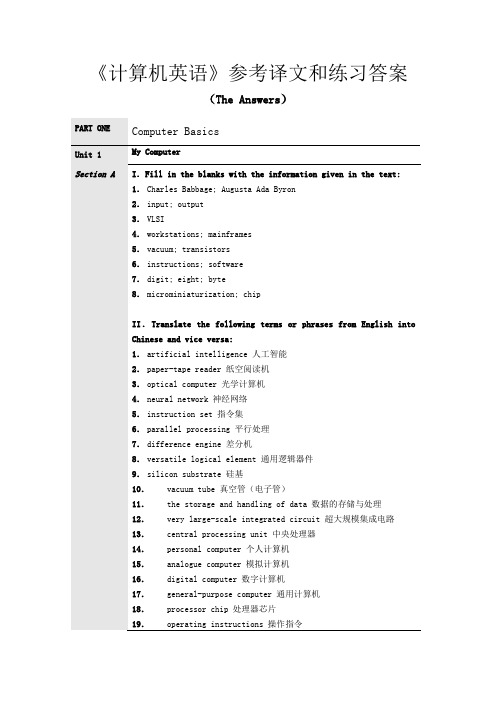
(The Answers) Answers)
PART ONE
Computer Basics
My Computer Unit 1
Section A
I.Fill in the blanks with the information given in the text: 1. Charles Babbage; Augusta Ada Byron 2. input; output 3. VLSI 4. workstations; mainframes 5. vacuum; transistors 6. instructions; software 7. digit; eight; byte 8. microminiaturization; chip
6. Pentium processor 奔腾处理器 7. virtual screen 虚拟屏幕 8. desktop computer specifications 台式计算机规格 9. radio frequency 射频 10. 10. wearable computer 可佩带式计算机
Section C
Unit 2
Computer Architecture I.Fill in the blanks with the information given in the text: 1. input; output; storage 2. Basic Input Output System 3. flatbed scanners; hand-held scanners 4. LCD-based 5. dot-matrix printers; inkjet printers 6. disk drives; memory 7. Volatile 8. serial; parallel
《计算机英语》课后习题答案

《计算机英语》参考答案Chapter 11.(1) 中央处理器(Central Processing Unit)(2) 随机访问内存(Random-access Memory)(3) 美国国际商用机器公司(International Business Machine)(4) 集成电路(Integrated Circuit)(5) 大规模集成电路(Large Scale Integration)(6) 超大规模集成电路(Very Large Scale Integration)(7) 个人数字助理(Personal Digital Assistant)(8) 图形用户界面(Graphical User Interface)2.(1) data(2) software(3) IC(4) ENIAC(5) supercomputer(6) superconductivity3.(1) F (ENIAC is the second digital computer after Atanasoff-Berry Computer)(2) T(3) F (Data is a unorganized)(4) T(5) T(6) T4.(1) 人工智能(2) 光计算机(3) 神经网络(4) 操作系统(5) 并行处理(6) vacuum tube(7) integrated circuit(8) electrical resistance(9) silicon chip(10) minicomputer5.数据是未经组织的内容的集合,数据可以包括字符、数字、图形和声音。
计算机管理数据,并将数据处理生成信息。
向计算机输入的数据称为输入,处理的结果称为输出。
计算机能在某一个称为存储器的地方保存数据和信息以备后用。
输入、处理、输出和存储的整个周期称为信息处理周期。
与计算机交互或使用计算机所产生信息的人称为用户。
1.(1) 发光二极管(Light-Emitting Diode)(2) 静态随机存储器(Static Random Access Memory)(3) 只读存储器(Read Only Memory)(4) 运算器(Arithmetic and Logical Unit)(5) 阴极射线管(Cathode Ray Tube)(6) 视频显示单元(Visual Display Unit)(7) 可编程只读存储器(Programmable Read Only Memory)(8) 液晶显示屏(Liquid Crystal Display)2.(1) CPU(2) peripheral(3) memory(4) modem(5) control unit(6) byte3.(1) T(2) T(3) F (RAM is volatile memory because the information within the computer chips is erased as soon as the computer is powered off whereas ROM is nonvolatile)(4) T(5) T(6) F (Microphones and digital cameras are input devices)4.(1) 寄存器组(2) 主机(3) 二进制的(4) 算法(5) 光盘(6) CD-RW(7) logic operation(8) barcode(9) peripheral device(10) volatile memory5.计算机的内存可被视为一系列的单元,可以在单元中存取数字。
计算机专业英语教程第四版翻译课后练习题含答案
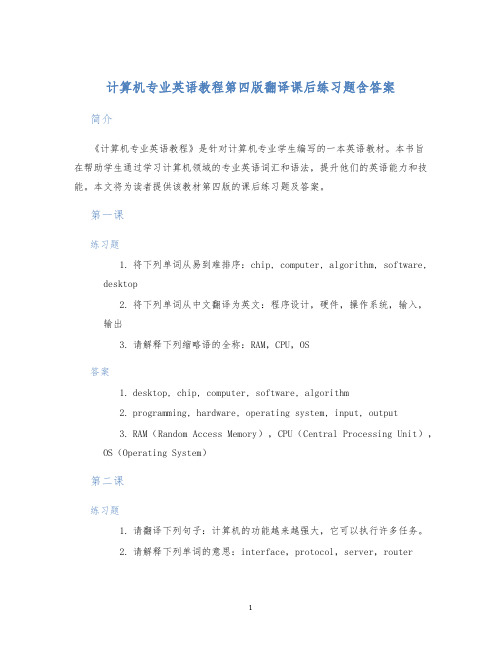
计算机专业英语教程第四版翻译课后练习题含答案简介《计算机专业英语教程》是针对计算机专业学生编写的一本英语教材。
本书旨在帮助学生通过学习计算机领域的专业英语词汇和语法,提升他们的英语能力和技能。
本文将为读者提供该教材第四版的课后练习题及答案。
第一课练习题1.将下列单词从易到难排序:chip, computer, algorithm, software,desktop2.将下列单词从中文翻译为英文:程序设计,硬件,操作系统,输入,输出3.请解释下列缩略语的全称:RAM,CPU,OS答案1.desktop, chip, computer, software, algorithm2.programming, hardware, operating system, input, output3.RAM(Random Access Memory),CPU(Central Processing Unit),OS(Operating System)第二课练习题1.请翻译下列句子:计算机的功能越来越强大,它可以执行许多任务。
2.请解释下列单词的意思:interface,protocol,server,router答案puters are becoming more and more powerful and they canperform many tasks.2.interface(接口), protocol(协议),server(服务器),router(路由器)第三课练习题1.请将下列单词按字母顺序排列:database,file,program,server,storage2.请填写下列句子的空格:计算机会读取从硬盘 __ (into)内存。
3.请解释下列单词的意思:database,algorithm,client,browser答案1.algorithm,database,file,program,server,storage2.into3.database(数据库),algorithm(算法),client(客户端),browser(浏览器)第四课练习题1.请翻译下列句子:今天我学会了如何编写计算机程序。
计算机专业英语第二版课后翻译答案
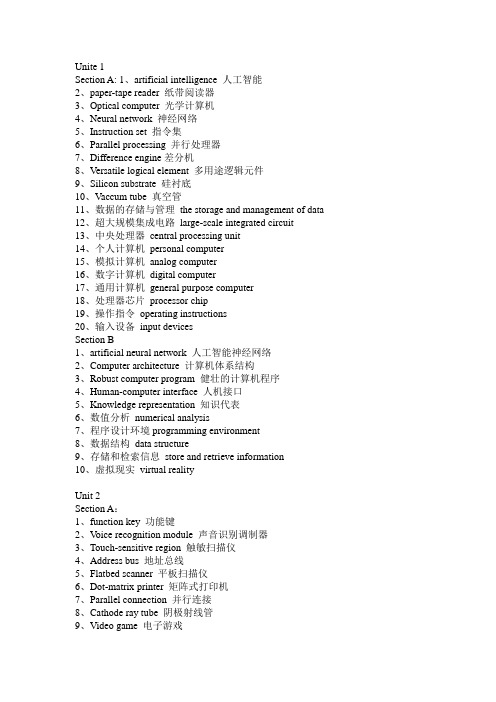
Unite 1Section A: 1、artificial intelligence 人工智能2、paper-tape reader 纸带阅读器3、Optical computer 光学计算机4、Neural network 神经网络5、Instruction set 指令集6、Parallel processing 并行处理器7、Difference engine差分机8、Versatile logical element 多用途逻辑元件9、Silicon substrate 硅衬底10、Vaccum tube 真空管11、数据的存储与管理the storage and management of data12、超大规模集成电路large-scale integrated circuit13、中央处理器central processing unit14、个人计算机personal computer15、模拟计算机analog computer16、数字计算机digital computer17、通用计算机general purpose computer18、处理器芯片processor chip19、操作指令operating instructions20、输入设备input devicesSection B1、artificial neural network 人工智能神经网络2、Computer architecture 计算机体系结构3、Robust computer program 健壮的计算机程序4、Human-computer interface 人机接口5、Knowledge representation 知识代表6、数值分析numerical analysis7、程序设计环境programming environment8、数据结构data structure9、存储和检索信息store and retrieve information10、虚拟现实virtual realityUnit 2Section A:1、function key 功能键2、V oice recognition module 声音识别调制器3、Touch-sensitive region 触敏扫描仪4、Address bus 地址总线5、Flatbed scanner 平板扫描仪6、Dot-matrix printer 矩阵式打印机7、Parallel connection 并行连接8、Cathode ray tube 阴极射线管9、Video game 电子游戏10、Audio signal 音频信号11、操作系统operating system12、液晶显示liquid crystal display13、喷墨打印机inkjet printer14、数据总线data bus15、串行连接serial connection16、易失性存储器volatile memory17、激光打印机laser printer18、磁盘存储器floppy disc19、基本输入输出系统basic input/output system20、视频显示器video displaySection B:1、interrupt handler 中断处理程序2、Virtual memory 虚拟内存3、Context switch 上下文转换4、Main memory 主存5、Bit pattern 位模式6、外围设备peripheral device7、进程表process table8、时间片time slice9、图形用户界面graphics user interface10、海量存储器mass storageUnit 3Section A:1、storage register 存储寄存器2、Function statement 函数语句3、Program statement 程序语句4、Object-oriented language 面向对象语言5、Assembly language 汇编语言6、Intermediate language 中间语言7、Relational language 关系语言8、Artificial language 人工语言9、Data declaration 数据声明10、SQL 结构化查询语言11、可执行程序executable program12、程序模块program module13、条件语句conditional statement14、赋值语句assignment statement15、逻辑语言logic statement16、机器语言machine language17、函数式语言functional language18、程序设计语言programming language19、运行计算机程序run a omputer program20、计算机程序员computer programmerSection B1、native code 本机代码2、Header file 头文件3、Multithreaded program 多线程程序4、Java-enabled browser 支持Java的浏览器5、Mallicious code6、机器码machine code7、汇编码assembly code8、特洛伊木马程序trojan9、软件包software package10、类层次class hierarchyUnit 4Section A1、inference engine 推理机2、System call 系统调用3、Compiled language 编译执行的语言4、Parellel computing 并行计算5、Pattern matching 模式匹配6、Memory location 存储单元7、Interpreter program 解释程序8、Library routine 库程序9、Intermediate program 中间程序10、Source file 源文件11、解释执行的语言interpreted language12、设备驱动程序device driver13、源程序source program14、调试程序debugger15、目标代码object code16、应用程序application program17、实用程序utility program18、逻辑程序logic program19、黑盒ink cartridge20、程序的存储与执行storage and execution of program Section B1、Messaging model 通信模式2、Common language runtime 通用语言运行时刻(环境)3、Hierarchical namespace 分层的名称空间4、Development community 开发社区5、CORBA 公共对象请求代理体系结构6、基本组件basic components7、元数据标记metadata token8、虚拟机VM virtual machine9、集成开发环境IDE(intergrated development environment)10、简单对象访问协议SOAP(simple object access protocol) Unit 5Section A1、system specification 系统规范2、Unit testing 单元测试3、Software life cycle 软件的生命周期4、System validation process 系统验证过程5、Evolutionary development process 进化发展过程6、Simple linear model 简单线性模型7、Program unit 程序单元8、Throwaway prototype 一次性使用原型9、Text formatting 文本格式10、System evolution 系统演变11、系统设计范例paradigm for system design12、需求分析与定义Requirements analysis and definition13、探索式编程方法exploratory programming approach14、系统文件编制system documentation15、瀑布模型waterfall model16、系统集成system integration17、商用现成软件commercial off-the-shelf software18、基于组件的软件工程component-based software engineering19、软件维护工具software maintenance tool20、软件复用software reuseSection B1、check box 复选框2、Structured design 结构化设计3、Building block 构建模块4、Database schema 数据库模式5、Radio button 单选按钮6、系统建模技术system modeling techniques7、模型驱动开发MDD(model-driven development)8、数据流程图data flow diagram9、下拉式菜单drop-down10、滚动条scroll barUnit 6Section A1、end user 终端用户2、Atomic operation 原子操作3、Database administrator 数据库管理员4、Relational database model 关系数据库模型5、Local data 本地数据6、Object-oriented database 面向对象的数据库7、Database management system 数据库管理系统8、Entity-relationship model 实体关系模型9、Distributed database 分布式数据库10、Flat file 展开文件11、二维表two-dimensional table12、数据属性data attributes13、数据库对象database object14、存储设备storage device15、数据类型data type16、数据插入与删除insertion and deletion17、层次数据库模型hierarchical18、数据库体系结构database architecture19、关系数据库管理系统ralational database management system20、全局控制总线global control busSection B1、nonvolatile storage system 易失性存储系统2、Equitment malfunction 设备故障3、Wound-wait protocol 损伤等待协议4、Exclusive lock 排它锁5、Database integrity 数据库完整性6、共享锁shared lock7、数据库实现database implementation8、级联回滚cascading rollback9、数据项data item10、分时操作系统time sharing operating system ;Unit 7Section A1、microwave radio 微波无线电2、digital television 数字电视3、DSL 数字用户线路4、analog transmission 模拟传输5、on-screen pointer 屏幕上的指针6、computer terminal 计算机终端7、radio telephone 无线电话8、cellular telephone 蜂窝电话,移动电话,手机9、decentralized network 分散型网络10、wire-based internal network 基于导线的内部网络,有线内部网11、光缆fiber-optic cable12、传真机fax machine13、线通信wireless communications14、点对点通信point-to-point communications15、调制电脉冲modulated electrical impulse16、通信卫星communication(s) satellite17、电报电键telegraph key18、传输媒体transmission medium (或media)19、无绳电话cordless telephone20、金属导体metal conductorSection B1、bit map 位图2、parallel port 并行端口3、direct memory access (DMA) 直接存储器存取4、universal serial bus 通用串行总线5、general-purpose register 通用寄存器6、电路板circuit board7、串行通信serial communication8、数码照相机digital camera9、存储映射输入/输出memory-mapped I/O10、有线电视cable televisionUnit 8Section A1、file server 文件服务器2、carrier sense 载波检测3、Protocol suite 协议族4、Peer-to-peer model 点对点模型5、bus topology network 总线拓扑网络6、inter-machine cooperation 计算机间合作7、Ethernet protocol collection 以太网协作集8、Proprietary network 专有网络9、utility package 实用软件包10、star network 星形网络11、局域网local area network (LAN)12、令牌环token ring13、无线网络wireless network14、封闭式网络closed network15、环形拓扑网络ring topology16、客户/服务机模型client/server model17、网络应用程序network application18、进程间通信interprocess communication19、打印服务机printer server20、广域网wide area networkSection B1、routing path 路由选择通路2、dual-ring topology 双环形拓扑结构3、extended star topology 扩展星形拓扑结构4、backbone network 基干网,骨干网5、mesh topology网络拓扑结构6、同轴电缆coaxial cable7、逻辑拓扑结构logical topology8、无冲突连网环境collision-free networking environment9、树形拓扑结构tree topology10、目的地节点destination nodeUnit 9Section A1、cell phone 蜂窝电话,移动电话,手机2、IP address 网际协议地址,IP地址3、autonomous system 自主系统4、dial-up connection 拨号连接5、network identifier 网络标识符6、binary notation 二进制记数法7、mnemonic name 助记名,缩写名8、Internet-wide directory system 因特网范围的目录系统9、name server 名称服务器10、Internet infrastructure 因特网基础结构11、助记地址mnemonic address12、网吧cyber cafe13、宽带因特网访问broadband Internet access14、顶级域名top-level domain (TLD)15、因特网编址Internet addressing16、点分十进制记数法dotted decimal notation17、因特网服务提供商Internet service provider (ISP)18、专用因特网连接dedicated Internet connection19、主机地址host address20、硬件与软件支持hardware and software support Section B1、incoming message 来报,到来的报文2、application layer 应用层3、utility software 实用软件4、sequence number (顺)序号,序列号5、remote login capabilities 远程登录能力6、端口号port number7、软件例程software routine8、传输层transport layer9、文件传送协议FTP(File Transfer Protocol)10、万维网浏览器Web browserUnit 10Section A1、mailing list 邮件发送清单,邮件列表2、proprietary software 专有软件3、cc line 抄送行4、bcc line 密送行5、forwarded e-mail messages 转发的电子邮件6、e-mail convention 电子邮件常规7、click on an icon 点击图标8、confidential document 密件,秘密文件9、classified information 密级信息10、recovered e-mail message 恢复的电子邮件11、常用情感符commonly used emoticon12、已删除电子邮件deleted e-mail13、电子系统electronic system14、附件行Attachments line15、版权法copyright law16、电子邮件网规e-mail netiquette17、信息高速公路information superhighway18、签名文件signature file19、电子数据表程序spreadsheet program20、文字处理软件word processorSection B1、web-authoring software 网络写作软件2、template generator 模版生成程序3、navigation page 导航页面4、corporate logo 公司标识5、splash page 醒目页面,过渡页6、导航条navigation bar7、节点页面node page8、网站地图site map9、可用性测试usability testing10、图形交换格式gif(Graphics Interchange Format)Unit 11Section A1、customized marketing strategy 定制的营销策略2、B2G transaction 企业对政府交易3、mobile telephone 移动电话4、dot-com bust 网络不景气5、smart card 智能卡,灵巧卡6、digital piracy 数字盗版7、dot-com boom 网络繁荣8、C2C transaction 消费者对消费者交易9、Web auction site 拍卖网站10、fingerprint reader 指纹读取器11、射频识别装置radio-frequency identification (RFID) device12、电子数据交换electronic data interchange (EDI)13、库存管理技术inventory management technology14、知识产权intellectual property15、条形码bar code16、货币兑换currency conversion17、电子图书electronic book18、视网膜扫描仪retina scanner19、个人数字助理personal digital assistant (PDA)20、企业对企业电子商务B2B electronic commerceSection B1、software suite 软件套件2、text box 文本框3、virtual checkout counter 虚拟付款台4、static catalog 静态目录5、browser session 浏览器会话期6、动态目录dynamic catalog7、购物车软件shopping cart software8、供应链supply chain9、企业资源计划软件enterprise resource planning (ERP) software10、税率tax rateUnit 12Section A1、encryption program 加密程序2、deletion command 删除命令3、authorized user 授权的用户4、backup copy 备份5、voltage surge 电压浪涌6、circuit breaker 断路器7、electronic component 电子元件(或部件)8、data-entry error 数据输入错误9、electronic break-in 电子入侵10、power line 电力线,输电线11、检测程序detection program12、电源power source13、破坏性计算机程序destructive computer program14、计算机病毒computer virus15、软件侵权software piracy16、硬盘驱动器hard-disk drive17、病毒检查程序virus checker18、主存储器primary storage19、电子公告板electronic bulletin board20、浪涌电压保护器surge protectorSection B1、phishing attack 网络钓鱼攻击2、graphics card 显(示)卡3、heuristic analysis 试探性分析4、infected file 被感染文件5、virus dictionary 病毒字典6、数据捕获data capture7、恶意软件malicious software8、病毒特征代码virus signature9、防病毒软件antivirus software10、内存驻留程序memory-resident program。
《计算机专业英语》习题参考答案
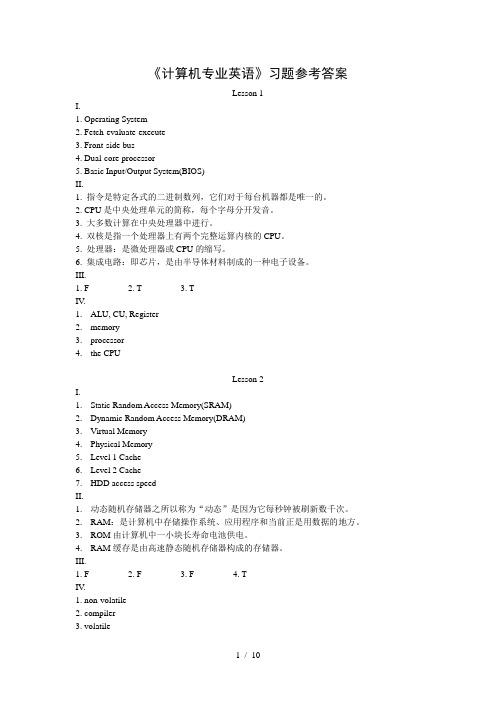
《计算机专业英语》习题参考答案Lesson 1I.1. Operating System2. Fetch-evaluate-execute3. Front-side bus4. Dual-core processor5. Basic Input/Output System(BIOS)II.1. 指令是特定各式的二进制数列,它们对于每台机器都是唯一的。
2. CPU是中央处理单元的简称,每个字母分开发音。
3. 大多数计算在中央处理器中进行。
4. 双核是指一个处理器上有两个完整运算内核的CPU。
5. 处理器:是微处理器或CPU的缩写。
6. 集成电路:即芯片,是由半导体材料制成的一种电子设备。
III.1. F2. T3. TIV.1.ALU, CU, Register2.memory3.processor4.the CPULesson 2I.1.Static Random Access Memory(SRAM)2.Dynamic Random Access Memory(DRAM)3.Virtual Memory4.Physical Memory5.Level 1 Cache6.Level 2 Cache7.HDD access speedII.1.动态随机存储器之所以称为“动态”是因为它每秒钟被刷新数千次。
2.RAM:是计算机中存储操作系统、应用程序和当前正是用数据的地方。
3.ROM由计算机中一小块长寿命电池供电。
4.RAM缓存是由高速静态随机存储器构成的存储器。
III.1. F2. F3. F4. TIV.1. non-volatile2. compiler3. volatile4. DRAMLesson 3I.1. Motherboard2. PC Case3. Hard Disk Drive(HDD)4. Optical mouse5. RAM6. Mobile DiskII.1.PC是有很多组件构成的一个系统。
计算机专业英语的第四版课后习题翻译
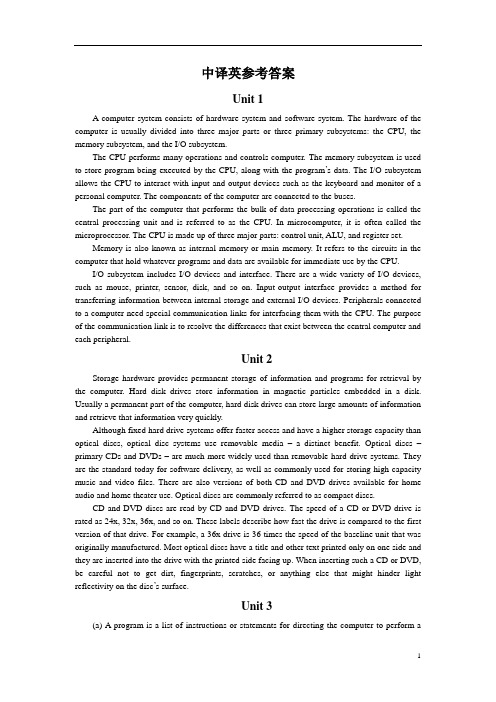
中译英参考答案Unit 1A computer system consists of hardware system and software system. The hardware of the computer is usually divided into three major parts or three primary subsystems: the CPU, the memory subsystem, and the I/O subsystem.The CPU performs many operations and controls computer. The memory subsystem is used to store program being executed by the CPU, along with the program’s data. The I/O subsystem allows the CPU to interact with input and output devices such as the keyboard and monitor of a personal computer. The components of the computer are connected to the buses.The part of the computer that performs the bulk of data processing operations is called the central processing unit and is referred to as the CPU. In microcomputer, it is often called the microprocessor. The CPU is made up of three major parts: control unit, ALU, and register set.Memory is also known as internal memory or main memory. It refers to the circuits in the computer that hold whatever programs and data are available for immediate use by the CPU.I/O subsystem includes I/O devices and interface. There are a wide variety of I/O devices, such as mouse, printer, sensor, disk, and so on. Input-output interface provides a method for transferring information between internal storage and external I/O devices. Peripherals connected to a computer need special communication links for interfacing them with the CPU. The purpose of the communication link is to resolve the differences that exist between the central computer and each peripheral.Unit 2Storage hardware provides permanent storage of information and programs for retrieval by the computer. Hard disk drives store information in magnetic particles embedded in a disk. Usually a permanent part of the computer, hard disk drives can store large amounts of information and retrieve that information very quickly.Although fixed hard drive systems offer faster access and have a higher storage capacity than optical discs, optical disc systems use removable media –a distinct benefit. Optical discs –primary CDs and DVDs – are much more widely used than removable hard drive systems. They are the standard today for software delivery, as well as commonly used for storing high-capacity music and video files. There are also versions of both CD and DVD drives available for home audio and home theater use. Optical discs are commonly referred to as compact discs.CD and DVD discs are read by CD and DVD drives. The speed of a CD or DVD drive is rated as 24x, 32x, 36x, and so on. These labels describe how fast the drive is compared to the first version of that drive. For example, a 36x drive is 36 times the speed of the baseline unit that was originally manufactured. Most optical discs have a title and other text printed only on one side and they are inserted into the drive with the printed side facing up. When inserting such a CD or DVD, be careful not to get dirt, fingerprints, scratches, or anything else that might hinder light reflectivity on the disc’s surface.Unit 3(a) A program is a list of instructions or statements for directing the computer to perform arequired data processing task. Programming is a multistep process for creating that list of instructions.(b) It is important to understand the difference between a class and an object of that class. A class is simply a specification for creating objects. Thus, a single class may create multiple objects.(c) Java is an object-oriented, network-friendly high-lever programming language that allows programmers to build applications that can run on almost any operating system.(d) ActiveX is a set of controls, or reusable components that enables programs or content of almost any type to be embedded within a Web page. Whereas a Java must be downloaded each time you visit a Web site, with ActiveX the component is downloaded only once, then stored on your hard disk for later, repeated use.(e) Programming involves a great deal of creativity. The design is guide to the function or purpose of each component, but the programmer has great flexibility in implementing the design as code. No matter what language is used, each program component involves at least three major aspects: control structures, algorithms, and data structures.Unit 4The software system can be divided into two broad categories: application software and system software. Application software consists of the program for performing tasks particular to the machine’s utilization. In contrast to application software, system software comprises a large number of programs. These programs start up the computer and function as the principle coordinator of all hardware components and application software. Without system software loaded into RAM of your computer, your hardware and application software are useless.System software can be grouped into three basic parts: operating system, utility software, and language translators. The majority of an installation’s utility software consists of programs for performing activities that are fundamental to computer installations yet not included in the operating system. In a sense, utility software consists of software units that extend the capabilities of the operating system.A computer’s OS is the main collection of programs that manage its activities. The primary chores of an OS are management and control. The OS ensures that all actions requested by a user are valid and processed in an orderly fashion. It also manages the computer system’s resources to perform these operations with efficiency and consistency.Application software is the software designed to help you solve problems specific to business or perform specific business tasks. Application software then is the layer of software closest to you. Basically, there are four categories of application software: productivity software, business and specialty software, entertainment software and education/reference software.Unit 5A computer network is often classified as being either a local area network (LAN), a metropolitan area network (WAN), or a wide area network (WAN). The connection of two or more networks is called an internetwork. The worldwide Internet is a well-known example of an internetwork.LANs are privately owned networks within a single building or campus of up to a few kilometers in size. They are widely used to connect personal computers and workstations incompany offices and factories to share resources and exchange information.In general, a given LAN will use only one type of transmission medium. Various topologies are possible for LANs. The most common LAN topologies are bus, ring and star.A MAN is basically a bigger version of a LAN and normally uses similar technology. MAN is designed to extend over an entire city. It may be a single network such as a cable television network, or it may be a means of connecting a number of LANs into a large network so that resources may be shared LAN-to-LAN as well as device-to-device. For example, a company can use a MAN to connect the LANs in all of its offices throughout a city.A W AN spans a large geographical area that may comprise a country, a continent, or even the world. It provides long-distance transmission of data, voice, image, and video information over large geographical area.In contrast to LANs, W ANs may utilize public leased, or private communication devices, usually in combinations, and can therefore span an unlimited number of miles.Unit 6Transmission media are used to transfer messages over a network. For instance, the transmission media used in a network may be a privately owned set of cables, the public phone lines, or a satellite system. Transmission media can either be wired or wireless.The three types of wired media most commonly used to carry messages are twisted-pair wire, coaxial cable, and fiber-optic cable. One of the most successful developments in transmission media in recent years has been fiber optics. Fiber-optic cable is commonly used for the high-speed backbone lines of a network, or for Internet infrastructure.Wireless transmission media have become especially popular in recent years. They support communications in situations in which physical wiring is impractical or inconvenient, as well as facilitate mobility. Wireless media are commonly used to connect devices to a network, to share information between computers, to connect wireless mice to a computer, and for handheld PCs, wireless phones, and other mobile devices. Radio signals transferred through the air are the heart of most types of wireless media. In addition to conventional broadcast radio application, the microwave, cellular, and satellite transmission media also use radio signals to transmit data.Radio transmissions require the use of a transmitter to send the radio signals through the air.A receiver (usually containing some type of antenna) accepts the date at the other end. When a device functions as both a receiver and transmitter, it is commonly called a transceiver or transmitter-receiver.Unit 7(a) Since many database systems users are not computer trained, developers hide the complexity from users through several levels of abstraction, to simplify user’s interactions with the system: physical level, logical level, and view level.(b) A database schema is specified by a set of definitions expressed by a special language called a data-definition language (DDL). The result of compilation of DDL statements is a set of tables that is stored in a special file called data dictionary, or data directory.(c) The structured query language (SQL) is the most widely used and standard query language for relational database management systems. It is a kind of non-procedural language.(d) An entity is a “thing”or “object”in the real world that is distinguishable from otherobjects. For example, each person is an entity, and bank accounts can be considered to be entities. Entities are described in a database by a set of attributes.(e) Data warehouse is one of the newest and hottest buzzwords and concepts in the IT field and the business environment. A data warehouse is a logical collection of information——gathered from many different operational databases——that supports business analysis activities and decision-making tasks.Unit 8Animation is the term used to describe a series of graphical images that are displayed one after the other to simulate movement. Cartoons on television are one example of animation.Video differs from animation in that it usually begins as a continuous stream of visual information that is broken into separate images or frames when the video is recorded. When the frames are projected—typically at a rate of 30 frames per second—the effect is a smooth reconstruction of the original continuous stream of information. As you might imagine, at 30 frames per second, the amount of data involved in displaying a video during a multimedia presentation can require a substantial amount of storage space. Consequently, video data—like audio data—is often compressed. A variety of compression standards exist. Some of the most common video file formats are .avi, .mpeg, .mov, .rm.For multimedia presentation, video may be recorded using a standard (analog) video camera and then converted to digital form as it is input into a computer. Alternatively, the film can be recording digitally using a digital video camera. Streaming video is frequently used on Web pages to reduce file size. Similar to streaming audio, Streaming video files can begin playing once a portion of the video has been downloaded.Unit 9(a) AI is currently being applied in business in the form of knowledge systems, which use human knowledge to solve problems. The most popular type of knowledge-based system is the expert system. An expert system is a computer program that attempts to represent the knowledge of human experts in the form of heuristics. The term heuristic is derived from the same Greek root as the word eureka, which means “to discover”.(b) The user interface enables the manager to enter instructions and information into the expert system and to receive information from it. The instructions specify the parameters that guide the expert system through its reasoning processing. The information is in the form of values assigned to certain variables.(c) The knowledge base contains both facts that describe the problem area and knowledge representation techniques that describe how the facts fit together in a logical manner. The term problem domain is used to describe the problem area.(d) An expert system, also called a knowledge-based system, is an artificial intelligence system that applies reasoning capabilities to reach a conclusion. Expert systems are excellent for diagnostic and prescriptive problems.(e) The DSS is not intended to replace the manager. The computer can be applied to the structured portion of the problem, but the manager is responsible for the unstructured portion——applying judgment or intuition and conducting analyses.Unit 10The linked list (see figure 1) consists of a series of nodes, which are not necessarily adjacent in memory. Each node contains the element and a link to a node containing its successor. We call this the next link. The last cell’s next link references null.To execute printList or find(x) we merely start at the first node in the list and then traverse the list by following the next links. This operation is clearly linear-time, as in the array implementation, although the constant is likely to be larger than if an array implementation were used. The findKth operation is no longer quite as efficient as an array implementation; findKth(i) takes O(i) time and works by traversing down the list in the obvious manner. In practice, this bound is pessimistic, because frequently the calls to findKth are in sorted order (by i). As an example, findKth(2), findKth(3), findKth(4), and findKth(6) can all be executed in one scan down the list.The remove method can be executed in one next reference change. Figure 2 shows the result of deleting the second element in the original list.The insert method requires obtaining a new node from the system by using a new call and then executing two reference maneuvers. The general idea is shown in figure 3. The dashed line represents the old next reference.figure 1figure 2figure 3Unit 11(a) A set is pure if all of its members are sets, all members of its members are sets, and so on. For example, the set containing only the empty set is a nonempty pure set.(b) A language is a describable set of finite strings, drawn from a fixed alphabet. A grammar is one way to "describe" the language. The grammar consists of a finite list of rules, where each rule replaces one substring with another. The string on the left must contain at least one nonterminal. The first string "produces" or "generates" the second. Thus a rule is also called a production.(c) A finite-state machine (FSM) or finite-state automaton(FA)is a mathematical abstraction sometimes used to design digital logic or computer programs. It is a behavior model composed of a finite number of states, transitions between those states, and actions, similar to a flow graph in which one can inspect the way logic runs when certain conditions are met.(d) Sometimes it is inconvenient or impossible to describe a set by listing all of its elements. Another useful way to define a set is by specifying a property that the elements of the set have in common. The notation P(x) is used to denote a sentence or statement P concerning the variable object x. The set defined by P(x) written {x | P(x)}, is just a collection of all the objects for whichP is true.Unit 12(a) Because drawings are typically displayed in 3D, CAD is especially helpful in designing automobiles, aircraft, ships, buildings, electrical circuits (including computer chips), and even clothing.(b) Computer-integrated manufacturing (CIM) is the manufacturing approach of using computers to control the entire production process. This integration allows individual processes to exchange information with each other and initiate actions. Through the integration of computers, manufacturing can be faster and less error-prone, although the main advantage is the ability to create automated manufacturing processes.(c) In addition to supporting decision making, coordination, and control, information system may also help managers and workers analyze problems, visualize complex subjects, and create new products.(d) Knowing the history and evolution of ERP is essential to understanding its current application and its future developments.(e) In addition to monitoring operational activities such as tracking the status of orders and inventory levels, enterprise system also improve organization-wide reporting and decision making.Unit 13(a) There are a wide variety of educational application programs available. Educational software is designed to teach one or more skills, such as reading, math, spelling, a foreign language, world geography, or to help prepare for standardized tests.(b) Electronic business (e-business) is the use of information technology and electronic communication networks to exchange business information and conduct transactions in electronic, paperless form.(c) Word processing software allows you to use computers to create, edit, store, and print documents. You can easily insert, delete, and move words, sentences, and paragraphs——without ever using an eraser.(d) What is a spreadsheet? Spreadsheet software takes its name from the accountant’s columnar worksheet, which it imitates. A spreadsheet is a worksheet consisting of a collection of cells formed by the intersection of rows and columns. Each cell can store one piece of information: a number, word or phrase, or formula.Unit 14(a) A geographic information system (GIS) is a system that captures, stores, analyzes, manages and presents data with reference to geographic location data. In the simplest terms, GIS is the merging of cartography, statistical analysis and database technology.(b) The GPS receiver uses the messages it receives to determine the transit time of each message and computes the distance to each satellite. These distances along with the satellites' locations are used to compute the position of the receiver. This position is then displayed, perhaps with a moving map display or latitude and longitude; elevation information may be included.(c) Virtual reality (VR) is a term that applies to computer-simulated environments that can simulate physical presence in the real world. Most current virtual reality environments areprimarily visual experiences, displayed either on a computer screen or through special stereoscopic displays, but some simulations include additional sensory information, such as sound through speakers or headphones.Unit 15(a) The software development process is sometimes called the software development life cycle (SDLC), because it describes the life of a software product from its conception to its implementation, delivery, use, and maintenance.(b) How can the CMM help your organization? There are three key roles the CMM plays. First, the CMM helps build an understanding of software process by describing the practices that contribute to a level of process maturity. The second role of the CMM is to provide a consistent basis for conducting appraisals of software processes. The CMM’s third key role is to serve as a blueprint for software process improvement.(c) The UML offers a standard way to write a system’s blueprints, including conceptual things such as business processes and system functions as well as concrete things such as programming language statements, database schemas, and reusable software components. The UML represents a collection of the best engineering practices that have proven successful in the modeling of large and complex systems.(d) Object modeling is a technique for identifying objects within the system environment and the relationships between those objects. The object-oriented approach to system development is based on several concepts, such as object, attribute, behavior, encapsulation, class, inheritance, polymorphism, persistence, etc.Unit 16“Security” is an all-encompassing term that describes all the concepts, techniques, and technologies to protect information from unauthorized access. There are several requirements for information security.Confidentiality: hiding data, usually with encryption, to prevent unauthorized viewing and access.Authenticity: the ability to know that the person or system you are communicating with is who or what you think it is.Access control: once a person or system has been authenticated, their ability to access data and use systems is determined by access controls.Data integrity: providing assurance that an information system or data is genuine.Availability: making sure that information is available to users in a secure way.To prevent unauthorized access, some type of identification procedure must be used. These vary from passwords to physical access object (access cards, etc.) to biometric devices that verify some type of personal characteristic, such as a fingerprint.Some of the most secure access control systems address both identification and authentication. Identification involves verifying that the person’s name or other identifying feature is listed as an authorized user; authentication refers to determining whether or not the person is actually who he or she claims to be.Unit 17A distributed system is a collection of independent computers which appear to the users of system as a single computer. Nearly all large software systems are distributed. For example, enterprise-wide business systems must support multiple users running common applications across different sites.A distributed system encompasses a variety of applications, their underlying support software, the hardware they run on, and the communication links connecting the distributed hardware. The largest and best-known distributed system is the set of computers, software, and services comprising the World Wide Web, which is so pervasive that it coexists with and connects to most other existing distributed systems. The most common distributed systems are networked client/server systems. Distributed systems share the general properties described below.●Multiple nodes●Message passing or communication●Resource sharing●Decentralized control●Concurrency or parallelism●Fault tolerance●Heterogeneity●OpennessDistributed systems have many inherent advantages, especially over centralized systems. Some applications are inherent distributed as well. In general, distributed systems:●Yield higher performance●Allow incremental growth●Allow one user to run a program on many different machines in parallel●Provide higher reliability。
计算机专业英语阅读材料参考译文

阅读材料参考译文第1章计算机的种类和基本特征数字计算机分为专用型和通用型,从字面意义可以看出,设计专用计算机是用来完成某一个特殊任务的。
指令程序可以串入或永远储存在机器中,虽然缺乏灵活性,但却可以快速有效地完成某一项单独的任务。
为解决复杂的航海问题而设计的专用处理器已经在国外的美国原子潜水艇中建立。
然而,就在不久以前,对绝大多数的应用来说专用计算机都太昂贵了。
只有一些机构需要很少数量的专用计算机,并且专用模型有可能根本不会产生任何效果。
但是现在,定制的微型计算机已经被大量制造来完成诸如监视家庭设备、控制燃料和点火装置、汽车装置系统运行等任务。
并且,快速处理器已经可以用来发展自动设计工具,工程师可以为了专门的目的从经济的角度考虑生产少量的复杂微型计算机芯片。
通用计算机可以存储不同的程序,因此可以在无数的应用中使用。
可以发现,使用不同的指令,计算机可以在前一分钟处理工资表,而在下一分钟处理帐单申请。
可以编写新程序,旧程序可以修改或删除。
限制通用系统灵活性的仅仅是人类的想象能力。
所以,除非特别指出,之后所讨论的“计算机”都是通用数字系统。
人们关心的所有计算机系统都很相似,包括硬件输入、中央处理器和输出。
计算机存储的程序可以快速变化来允许不同申请流的处理,在这些存储程序的指令下,计算机系统可以完成基本的机器指令。
当然,更广泛的不同种类的应用需要不同的系统资源来处理之。
也就是说,用于玩太空侵略的家用个人计算机不可能用于完成美国国家航天航空总署2 计算机专业英语(NA SA)的任务,比如控制监视真实太空中航天飞机的发射。
现代计算机的物理大小各不相同,从可以装满房间到只有一角银币大小的中央处理器(CPU)。
一般来说,系统越大,处理速度越快,存储容量越大,当然价钱也越高。
除此之外,较大的系统能够更好地控制大量更加强大的输入和输出装置。
尺寸达到最小下界的系统可以称为微型计算机或小型计算机。
微型计算机或个人计算机是最小的通用系统。
《计算机英语(第4版)》课后练习参考答案
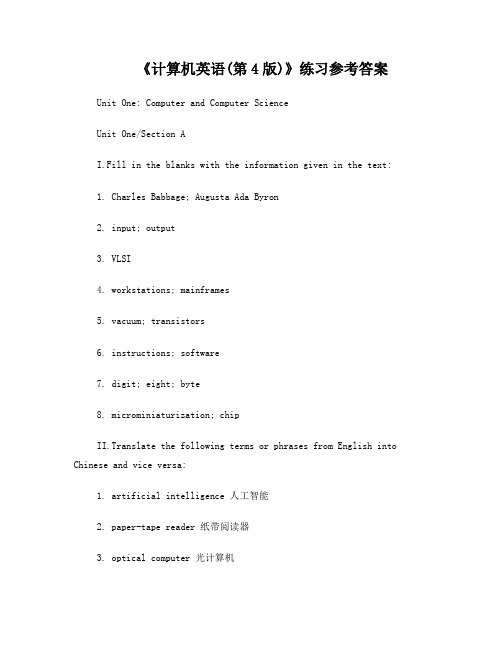
《计算机英语(第4版)》练习参考答案Unit One: Computer and Computer ScienceUnit One/Section AI.Fill in the blanks with the information given in the text:1. Charles Babbage; Augusta Ada Byron2. input; output3. VLSI4. workstations; mainframes5. vacuum; transistors6. instructions; software7. digit; eight; byte8. microminiaturization; chipII.Translate the following terms or phrases from English into Chinese and vice versa:1. artificial intelligence 人工智能2. paper-tape reader 纸带阅读器3. optical computer 光计算机4. neural network 神经网络5. instruction set 指令集6. parallel processing 并行处理7. difference engine 差分机8. versatile logical element 通用逻辑元件9. silicon substrate 硅衬底10. vacuum tube 真空管11. 数据的存储与处理the storage and handling of data12. 超大规模集成电路very large-scale integrated circuit13. 中央处理器central processing unit14. 个人计算机personal computer15. 模拟计算机analogue computer16. 数字计算机digital computer17. 通用计算机general-purpose computer18. 处理器芯片processor chip19. 操作指令operating instructions20. 输入设备input deviceIII.Fill in each of the blanks with one of the words given in the following list, making changes if necessary:We can define a computer as a device that accepts input, processes data, stores data, and produces output. According to the mode of processing, computers are either analog or digital.They can also be classified as mainframes, minicomputers, workstations, or microcomputers.All else (for example, the age of the machine) being equal, this categorization p rovides some indication of the compu ter’s speed, size, cost, and abilities.Ever since the advent of computers, there have been constant changes. First-generation computers of historic significance, such as UNIVAC(通用自动计算机), introduced in the early 1950s, were based on vacuum tubes. Second-generation computers, appearing in the early 1960s, were those in which transistors replaced vacuum tubes. In third-generation computers, dating from the 1960s, integrated circuitsreplaced transistors. In fourth-generation computers such as microcomputers, which first appeared in the mid-1970s, large-scale integration enabled thousands of circuits to be incorporated on one chip. Fifth-generation computers are expected to combine very-large-scale integration with sophisticated approaches to computing, includingartificial intelligence and true distributed processing.IV. Translate the following passage from English into Chinese:计算机将变得更加先进,也将变得更加容易使用。
计算机专业英语第二版课后翻译答案

Unite 1Section A: 1、artificial intelligence 人工智能2、paper-tape reader 纸带阅读器3、Optical computer 光学计算机4、Neural network 神经网络5、Instruction set 指令集6、Parallel processing 并行处理器7、Difference engine差分机8、Versatile logical element 多用途逻辑元件9、Silicon substrate 硅衬底10、Vaccum tube 真空管11、数据的存储与管理the storage and management of data12、超大规模集成电路large-scale integrated circuit13、中央处理器central processing unit14、个人计算机personal computer15、模拟计算机analog computer16、数字计算机digital computer17、通用计算机general purpose computer18、处理器芯片processor chip19、操作指令operating instructions20、输入设备input devicesSection B1、artificial neural network 人工智能神经网络2、Computer architecture 计算机体系结构3、Robust computer program 健壮的计算机程序4、Human-computer interface 人机接口5、Knowledge representation 知识代表6、数值分析numerical analysis7、程序设计环境programming environment8、数据结构data structure9、存储和检索信息store and retrieve information10、虚拟现实virtual realityUnit 2Section A:1、function key 功能键2、V oice recognition module 声音识别调制器3、Touch-sensitive region 触敏扫描仪4、Address bus 地址总线5、Flatbed scanner 平板扫描仪6、Dot-matrix printer 矩阵式打印机7、Parallel connection 并行连接8、Cathode ray tube 阴极射线管9、Video game 电子游戏10、Audio signal 音频信号11、操作系统operating system12、液晶显示liquid crystal display13、喷墨打印机inkjet printer14、数据总线data bus15、串行连接serial connection16、易失性存储器volatile memory17、激光打印机laser printer18、磁盘存储器floppy disc19、基本输入输出系统basic input/output system20、视频显示器video displaySection B:1、interrupt handler 中断处理程序2、Virtual memory 虚拟内存3、Context switch 上下文转换4、Main memory 主存5、Bit pattern 位模式6、外围设备peripheral device7、进程表process table8、时间片time slice9、图形用户界面graphics user interface10、海量存储器mass storageUnit 3Section A:1、storage register 存储寄存器2、Function statement 函数语句3、Program statement 程序语句4、Object-oriented language 面向对象语言5、Assembly language 汇编语言6、Intermediate language 中间语言7、Relational language 关系语言8、Artificial language 人工语言9、Data declaration 数据声明10、SQL 结构化查询语言11、可执行程序executable program12、程序模块program module13、条件语句conditional statement14、赋值语句assignment statement15、逻辑语言logic statement16、机器语言machine language17、函数式语言functional language18、程序设计语言programming language19、运行计算机程序run a omputer program20、计算机程序员computer programmerSection B1、native code 本机代码2、Header file 头文件3、Multithreaded program 多线程程序4、Java-enabled browser 支持Java的浏览器5、Mallicious code6、机器码machine code7、汇编码assembly code8、特洛伊木马程序trojan9、软件包software package10、类层次class hierarchyUnit 4Section A1、inference engine 推理机2、System call 系统调用3、Compiled language 编译执行的语言4、Parellel computing 并行计算5、Pattern matching 模式匹配6、Memory location 存储单元7、Interpreter program 解释程序8、Library routine 库程序9、Intermediate program 中间程序10、Source file 源文件11、解释执行的语言interpreted language12、设备驱动程序device driver13、源程序source program14、调试程序debugger15、目标代码object code16、应用程序application program17、实用程序utility program18、逻辑程序logic program19、黑盒ink cartridge20、程序的存储与执行storage and execution of program Section B1、Messaging model 通信模式2、Common language runtime 通用语言运行时刻(环境)3、Hierarchical namespace 分层的名称空间4、Development community 开发社区5、CORBA 公共对象请求代理体系结构6、基本组件basic components7、元数据标记metadata token8、虚拟机VM virtual machine9、集成开发环境IDE(intergrated development environment)10、简单对象访问协议SOAP(simple object access protocol) Unit 5Section A1、system specification 系统规范2、Unit testing 单元测试3、Software life cycle 软件的生命周期4、System validation process 系统验证过程5、Evolutionary development process 进化发展过程6、Simple linear model 简单线性模型7、Program unit 程序单元8、Throwaway prototype 一次性使用原型9、Text formatting 文本格式10、System evolution 系统演变11、系统设计范例paradigm for system design12、需求分析与定义Requirements analysis and definition13、探索式编程方法exploratory programming approach14、系统文件编制system documentation15、瀑布模型waterfall model16、系统集成system integration17、商用现成软件commercial off-the-shelf software18、基于组件的软件工程component-based software engineering19、软件维护工具software maintenance tool20、软件复用software reuseSection B1、check box 复选框2、Structured design 结构化设计3、Building block 构建模块4、Database schema 数据库模式5、Radio button 单选按钮6、系统建模技术system modeling techniques7、模型驱动开发MDD(model-driven development)8、数据流程图data flow diagram9、下拉式菜单drop-down10、滚动条scroll barUnit 6Section A1、end user 终端用户2、Atomic operation 原子操作3、Database administrator 数据库管理员4、Relational database model 关系数据库模型5、Local data 本地数据6、Object-oriented database 面向对象的数据库7、Database management system 数据库管理系统8、Entity-relationship model 实体关系模型9、Distributed database 分布式数据库10、Flat file 展开文件11、二维表two-dimensional table12、数据属性data attributes13、数据库对象database object14、存储设备storage device15、数据类型data type16、数据插入与删除insertion and deletion17、层次数据库模型hierarchical18、数据库体系结构database architecture19、关系数据库管理系统ralational database management system20、全局控制总线global control busSection B1、nonvolatile storage system 易失性存储系统2、Equitment malfunction 设备故障3、Wound-wait protocol 损伤等待协议4、Exclusive lock 排它锁5、Database integrity 数据库完整性6、共享锁shared lock7、数据库实现database implementation8、级联回滚cascading rollback9、数据项data item10、分时操作系统time sharing operating system ;Unit 7Section A1、microwave radio 微波无线电2、digital television 数字电视3、DSL 数字用户线路4、analog transmission 模拟传输5、on-screen pointer 屏幕上的指针6、computer terminal 计算机终端7、radio telephone 无线电话8、cellular telephone 蜂窝电话,移动电话,手机9、decentralized network 分散型网络10、wire-based internal network 基于导线的内部网络,有线内部网11、光缆fiber-optic cable12、传真机fax machine13、线通信wireless communications14、点对点通信point-to-point communications15、调制电脉冲modulated electrical impulse16、通信卫星communication(s) satellite17、电报电键telegraph key18、传输媒体transmission medium (或media)19、无绳电话cordless telephone20、金属导体metal conductorSection B1、bit map 位图2、parallel port 并行端口3、direct memory access (DMA) 直接存储器存取4、universal serial bus 通用串行总线5、general-purpose register 通用寄存器6、电路板circuit board7、串行通信serial communication8、数码照相机digital camera9、存储映射输入/输出memory-mapped I/O10、有线电视cable televisionUnit 8Section A1、file server 文件服务器2、carrier sense 载波检测3、Protocol suite 协议族4、Peer-to-peer model 点对点模型5、bus topology network 总线拓扑网络6、inter-machine cooperation 计算机间合作7、Ethernet protocol collection 以太网协作集8、Proprietary network 专有网络9、utility package 实用软件包10、star network 星形网络11、局域网local area network (LAN)12、令牌环token ring13、无线网络wireless network14、封闭式网络closed network15、环形拓扑网络ring topology16、客户/服务机模型client/server model17、网络应用程序network application18、进程间通信interprocess communication19、打印服务机printer server20、广域网wide area networkSection B1、routing path 路由选择通路2、dual-ring topology 双环形拓扑结构3、extended star topology 扩展星形拓扑结构4、backbone network 基干网,骨干网5、mesh topology网络拓扑结构6、同轴电缆coaxial cable7、逻辑拓扑结构logical topology8、无冲突连网环境collision-free networking environment9、树形拓扑结构tree topology10、目的地节点destination nodeUnit 9Section A1、cell phone 蜂窝电话,移动电话,手机2、IP address 网际协议地址,IP地址3、autonomous system 自主系统4、dial-up connection 拨号连接5、network identifier 网络标识符6、binary notation 二进制记数法7、mnemonic name 助记名,缩写名8、Internet-wide directory system 因特网范围的目录系统9、name server 名称服务器10、Internet infrastructure 因特网基础结构11、助记地址mnemonic address12、网吧cyber cafe13、宽带因特网访问broadband Internet access14、顶级域名top-level domain (TLD)15、因特网编址Internet addressing16、点分十进制记数法dotted decimal notation17、因特网服务提供商Internet service provider (ISP)18、专用因特网连接dedicated Internet connection19、主机地址host address20、硬件与软件支持hardware and software support Section B1、incoming message 来报,到来的报文2、application layer 应用层3、utility software 实用软件4、sequence number (顺)序号,序列号5、remote login capabilities 远程登录能力6、端口号port number7、软件例程software routine8、传输层transport layer9、文件传送协议FTP(File Transfer Protocol)10、万维网浏览器Web browserUnit 10Section A1、mailing list 邮件发送清单,邮件列表2、proprietary software 专有软件3、cc line 抄送行4、bcc line 密送行5、forwarded e-mail messages 转发的电子邮件6、e-mail convention 电子邮件常规7、click on an icon 点击图标8、confidential document 密件,秘密文件9、classified information 密级信息10、recovered e-mail message 恢复的电子邮件11、常用情感符commonly used emoticon12、已删除电子邮件deleted e-mail13、电子系统electronic system14、附件行Attachments line15、版权法copyright law16、电子邮件网规e-mail netiquette17、信息高速公路information superhighway18、签名文件signature file19、电子数据表程序spreadsheet program20、文字处理软件word processorSection B1、web-authoring software 网络写作软件2、template generator 模版生成程序3、navigation page 导航页面4、corporate logo 公司标识5、splash page 醒目页面,过渡页6、导航条navigation bar7、节点页面node page8、网站地图site map9、可用性测试usability testing10、图形交换格式gif(Graphics Interchange Format)Unit 11Section A1、customized marketing strategy 定制的营销策略2、B2G transaction 企业对政府交易3、mobile telephone 移动电话4、dot-com bust 网络不景气5、smart card 智能卡,灵巧卡6、digital piracy 数字盗版7、dot-com boom 网络繁荣8、C2C transaction 消费者对消费者交易9、Web auction site 拍卖网站10、fingerprint reader 指纹读取器11、射频识别装置radio-frequency identification (RFID) device12、电子数据交换electronic data interchange (EDI)13、库存管理技术inventory management technology14、知识产权intellectual property15、条形码bar code16、货币兑换currency conversion17、电子图书electronic book18、视网膜扫描仪retina scanner19、个人数字助理personal digital assistant (PDA)20、企业对企业电子商务B2B electronic commerceSection B1、software suite 软件套件2、text box 文本框3、virtual checkout counter 虚拟付款台4、static catalog 静态目录5、browser session 浏览器会话期6、动态目录dynamic catalog7、购物车软件shopping cart software8、供应链supply chain9、企业资源计划软件enterprise resource planning (ERP) software10、税率tax rateUnit 12Section A1、encryption program 加密程序2、deletion command 删除命令3、authorized user 授权的用户4、backup copy 备份5、voltage surge 电压浪涌6、circuit breaker 断路器7、electronic component 电子元件(或部件)8、data-entry error 数据输入错误9、electronic break-in 电子入侵10、power line 电力线,输电线11、检测程序detection program12、电源power source13、破坏性计算机程序destructive computer program14、计算机病毒computer virus15、软件侵权software piracy16、硬盘驱动器hard-disk drive17、病毒检查程序virus checker18、主存储器primary storage19、电子公告板electronic bulletin board20、浪涌电压保护器surge protectorSection B1、phishing attack 网络钓鱼攻击2、graphics card 显(示)卡3、heuristic analysis 试探性分析4、infected file 被感染文件5、virus dictionary 病毒字典6、数据捕获data capture7、恶意软件malicious software8、病毒特征代码virus signature9、防病毒软件antivirus software10、内存驻留程序memory-resident program。
《计算机英语(第4版)》课后练习参考答案
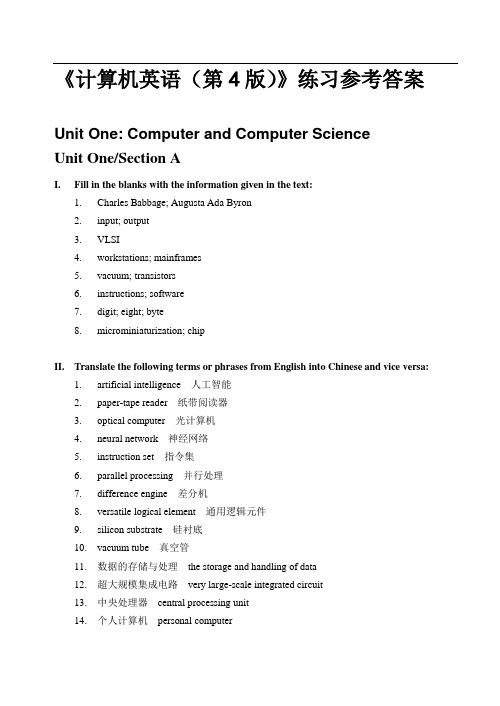
《计算机英语(第4版)》练习参考答案Unit One: Computer and Computer ScienceUnit One/Section AI.Fill in the blanks with the information given in the text:1. Charles Babbage; Augusta Ada Byron2. input; output3. VLSI4. workstations; mainframes5. vacuum; transistors6. instructions; software7. digit; eight; byte8. microminiaturization; chipII.Translate the following terms or phrases from English into Chinese and vice versa:1. artificial intelligence 人工智能2. paper-tape reader 纸带阅读器3. optical computer 光计算机4. neural network 神经网络5. instruction set 指令集6. parallel processing 并行处理7. difference engine 差分机8. versatile logical element 通用逻辑元件9. silicon substrate 硅衬底10. vacuum tube 真空管11. 数据的存储与处理the storage and handling of data12. 超大规模集成电路very large-scale integrated circuit13. 中央处理器central processing unit14. 个人计算机personal computer15. 模拟计算机analogue computer16. 数字计算机digital computer17. 通用计算机general-purpose computer18. 处理器芯片processor chip19. 操作指令operating instructions20. 输入设备input deviceIII.Fill in each of the blanks with one of the words given in the following list, making changes if necessary:We can define a computer as a device that accepts input, processes data, stores data, and produces output. According to the mode of processing, computers are either analog or digital.They can also be classified as mainframes, minicomputers, workstations, or microcomputers.All else (for example, the age of the machine) being equal, this categorization provides some indication of the compu ter’s speed, size, cost, and abilities.Ever since the advent of computers, there have been constant changes. First-generation computers of historic significance, such as UNIVAC(通用自动计算机), introduced in the early 1950s, were based on vacuum tubes. Second-generation computers, appearing in the early 1960s, were those in which transistors replaced vacuum tubes. In third-generation computers, dating from the 1960s, integrated circuits replaced transistors. In fourth-generation computers such as microcomputers, which first appeared in the mid-1970s, large-scale integration enabled thousands of circuits to be incorporated on one chip. Fifth-generation computers are expected to combine very-large-scale integration with sophisticated approaches to computing, including artificial intelligence and true distributed processing.IV. Translate the following passage from English into Chinese:计算机将变得更加先进,也将变得更加容易使用。
(刘艺第二版)计算机英语译文和答案
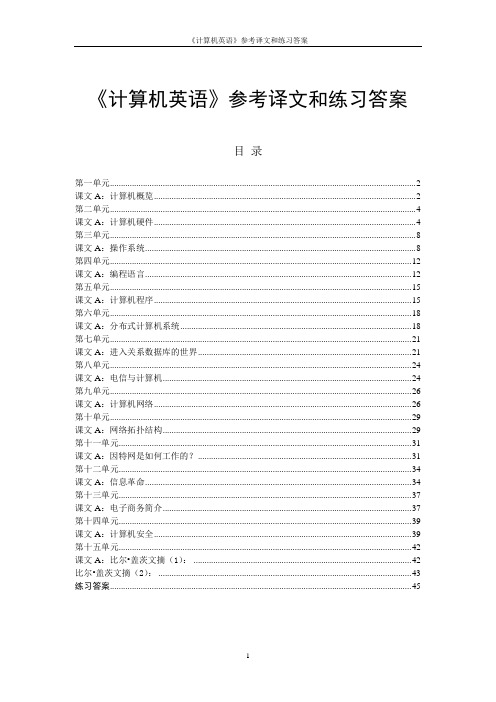
《计算机英语》参考译文和练习答案目录第一单元 (2)课文A:计算机概览 (2)第二单元 (4)课文A:计算机硬件 (4)第三单元 (8)课文A:操作系统 (8)第四单元 (12)课文A:编程语言 (12)第五单元 (15)课文A:计算机程序 (15)第六单元 (18)课文A:分布式计算机系统 (18)第七单元 (21)课文A:进入关系数据库的世界 (21)第八单元 (24)课文A:电信与计算机 (24)第九单元 (26)课文A:计算机网络 (26)第十单元 (29)课文A:网络拓扑结构 (29)第十一单元 (31)课文A:因特网是如何工作的? (31)第十二单元 (34)课文A:信息革命 (34)第十三单元 (37)课文A:电子商务简介 (37)第十四单元 (39)课文A:计算机安全 (39)第十五单元 (42)课文A:比尔•盖茨文摘(1): (42)比尔•盖茨文摘(2): (43)练习答案 (45)第一单元课文A:计算机概览一、引言计算机是一种电子设备,它能接收一套指令或一个程序,然后通过对数值数据进行运算或者对其他形式的信息进行处理来执行该程序。
如果没有计算机的发展,现代的高科技世界是不可能产生的。
在整个社会,不同型号和不同大小的计算机被用于存储和处理各种数据,从政府保密文件、银行交易到私人家庭账目。
计算机通过自动化技术开辟了制造业的新纪元,而且它们也增强了现代通信系统的性能。
在几乎每一个研究和应用技术领域,从构建宇宙模型到产生明天的气象报告,计算机无不是必要的工具,并且它们的应用本身就开辟了人们推测的新领域。
数据库服务和计算机网络使各种各样的信息源可供使用。
同样的先进技术也使侵犯个人隐私和商业秘密成为可能。
计算机犯罪已经成为作为现代技术代价组成部分的许多风险之一。
二、历史第一台加法机,数字计算机的先驱,是1642年由法国科学家、数学家兼哲学家布莱斯•帕斯卡设计的。
这个装置使用了一系列有10个齿的轮子,每个齿代表从0到9的一个数字。
- 1、下载文档前请自行甄别文档内容的完整性,平台不提供额外的编辑、内容补充、找答案等附加服务。
- 2、"仅部分预览"的文档,不可在线预览部分如存在完整性等问题,可反馈申请退款(可完整预览的文档不适用该条件!)。
- 3、如文档侵犯您的权益,请联系客服反馈,我们会尽快为您处理(人工客服工作时间:9:00-18:30)。
计算机英语参考译文和练习答案(doc 78页)《计算机英语》参考译文和练习答案目录第一单元 (2)课文A:计算机概览 (2)第二单元 (4)课文A:计算机硬件 (4)第三单元 (7)课文A:操作系统 (7)第四单元 (10)课文A:编程语言 (10)第五单元 (12)课文A:计算机程序 (12)第六单元 (16)课文A:分布式计算机系统 (16)第七单元 (19)课文A:进入关系数据库的世界 (19)第八单元 (22)课文A:电信与计算机 (22)第九单元 (24)课文A:计算机网络 (24)第十单元 (26)课文A:网络拓扑结构 (26)第十一单元 (29)课文A:因特网是如何工作的? (29)第十二单元 (31)课文A:信息革命 (31)第十三单元 (34)课文A:电子商务简介 (34)第十四单元 (37)课文A:计算机安全 (37)第十五单元 (40)课文A:比尔•盖茨文摘(1): (40)比尔•盖茨文摘(2): (41)练习答案 (43)第一单元课文A:计算机概览一、引言计算机是一种电子设备,它能接收一套指令或一个程序,然后通过对数值数据进行运算或者对其他形式的信息进行处理来执行该程序。
如果没有计算机的发展,现代的高科技世界是不可能产生的。
在整个社会,不同型号和不同大小的计算机被用于存储和处理各种数据,从政府保密文件、银行交易到私人家庭账目。
计算机通过自动化技术开辟了制造业的新纪元,而且它们也增强了现代通信系统的性能。
在几乎每一个研究和应用技术领域,从构建宇宙模型到产生明天的气象报告,计算机无不是必要的工具,并且它们的应用本身就开辟了人们推测的新领域。
数据库服务和计算机网络使各种各样的信息源可供使用。
同样的先进技术也使侵犯个人隐私和商业秘密成为可能。
计算机犯罪已经成为作为现代技术代价组成部分的许多风险之一。
二、历史第一台加法机,数字计算机的先驱,是1642年由法国科学家、数学家兼哲学家布莱斯•帕斯卡设计的。
这个装置使用了一系列有10个齿的轮子,每个齿代表从0到9的一个数字。
轮子互相连接,从而通过按照正确的齿数向前移动轮子,就可以将数字彼此相加。
在17世纪70年代,德国哲学家兼数学家戈特弗里德•威廉•莱布尼兹对这台机器进行了改良,设计了一台也能做乘法的机器。
法国发明家约瑟夫―玛丽•雅卡尔,在设计自动织机时,使用了穿孔的薄木板来控制复杂图案的编织。
在19世纪80年代期间,美国统计学家赫尔曼•何勒里斯,想出了使用类似雅卡尔的木板那样的穿孔卡片来处理数据的主义。
通过使用一种将穿孔卡片从电触点上移过的系统,他得以为1890年的美国人口普查汇编统计信息。
1、分析机也是在19世纪,英国数学家兼发明家查尔斯•巴比奇,提出了现代数字计算机的原理。
他构想出旨在处理复杂数学题的若干机器,如差分机。
许多历史学家认为巴比奇及其合伙人,数学家奥古斯塔•埃达•拜伦,是现代数字计算机的真正先驱。
巴比奇的设计之一,分析机,具有现代计算机的许多特征。
它有一个以一叠穿孔卡片的形式存在的输入流、一个储存数据的“仓库”、一个进行算术运算的“工厂”和一个产生永久纪录的打印机。
巴比奇未能将这个想法付诸实践,尽管在那个时代它在技术上很可能是可行的。
2、早期的计算机模拟计算机是在19世纪末期开始制造的。
早期型号是靠转动的轴和齿轮来进行计算的。
用任何其他方法都难以解答的方程,可以用这样的机器来求其近似数值。
开尔文勋爵制造了一台机械潮汐预报器,这实际上就是一台专用模拟计算机。
第一次和第二次世界大战期间,机械模拟计算系统以及后来的电动模拟计算系统,被用作潜艇上的鱼雷航线预测器和飞机上的轰炸瞄准具的控制器。
人们还设计了另一个系统,用于预测密西西比河流域春天的洪水。
3、电子计算机第二次世界大战期间,以伦敦北面的布莱切利公园为工作地点的一组科学家和数学家,制造了最早的全电子数字计算机之一:“巨人”。
到1943年12月,这个包含了1500个真空管的“巨人”开始运转了。
它被以艾伦•图灵为首的小组用于破译德国用恩尼格码加密的无线电报,他们的尝试大部分是成功的。
除此而外,在美国,约翰•阿塔纳索夫和克利福德•贝里早在1939年就在艾奥瓦州立学院制造了一台原型电子机。
这台原型机和后来的研究工作都是悄悄完成的,而且后来因1945年电子数字积分计算机(ENIAC)的研制而显得相形见绌。
ENIAC计算机被授予了专利。
但是,数十年后,在1973年,当该机被揭露吸收了在阿塔纳索夫―贝里计算机中首次使用的原理后,这项专利被废除。
ENIAC计算机(见图1A―1)含有18,000个真空管,具有每分钟几百次的运算速度,但是最初程序是通过导线传送到处理器内的,必须由人工更改。
根据美籍匈牙利数学家约翰•冯•诺伊曼的想法,后来制造的机器带有一个程序存储器。
指令像数据一样存储在“存储器”中,使计算机在执行过程中摆脱了纸带阅读器的速度限制,并使问题在不给计算机重新接线的情况下得以解决。
20世纪50年代末,晶体管在计算机中的应用,标志着比真空管机器更小、更快、更通用的逻辑元件的出现。
由于晶体管使用的功率小得多,寿命也长得多,仅这项发展本身就导致了被称之为第二代计算机的改良机器的产生。
元件变小了,元件的间距也变小了,而且系统的制造成本也变得低得多。
4、集成电路20世纪60年代末,集成电路得到采用,从而有可能将许多晶体管制作在一块硅衬底上,集体管之间以覆镀固定的导线相连接。
集成电路导致价格、尺寸和故障率的进一步降低。
20世纪70年代中期,随着大规模集成电路和后来的超大规模集成电路(微芯片)的采用,成千上万个彼此相连的晶体管被蚀刻在一块硅衬底上,于是微处理器成为现实。
那么,再回过头来看看现代计算机处理开关值的能力:20世纪70年代的计算机一般一次能够处理8个开关值。
也就是说,在每个循环中,它们能处理8个二进制数字或比特的数据。
8个比特为一组,称为一个字节;每个字节包含着256个开与关(或0与1)的可能模式。
每个模式相当于一条指令、一条指令的一部分或者一个特定的数据类型,如一个数字、一个字符或者一个图形符号。
例如,11010010这个模式可能是二进制数据——在这种情况下,代表210这个十进制数字——或者它可能是一条指令,告诉计算机将存储在其交换设备中的数据与存储在存储芯片某个位置的数据进行比较。
一次能处理16、32和64比特数据的处理器的研制,提高了计算机的速度。
一台计算机能够处理的全部可识别模式——操作总清单——被称为其指令集。
随着现代数字计算机的不断发展,这两个因素——能够同时处理的比特数和指令集的大小——在继续增长。
三、硬件不论尺寸大小,现代数字计算机在概念上都是类似的。
然而,根据成本与性能,它们可分为几类:个人计算机或微型计算机,一种成本相当低的机器,通常只有桌面大小(尽管“膝上型计算机”小到能够放入公文包,而“掌上型计算机”能够放入口袋);工作站,一种具有增强的图形与通信能力、从而使其对于办公室工作特别有用的微型计算机;小型计算机,一般就个人使用而言太昂贵,其性能适合于工商企业、学校或实验室;以及大型机,一种大型的昂贵机器,具有满足大规模工商企业、政府部门、科研机构或者诸如此类机构需要的能力(其中体积最大、速度最快的称为巨型计算机)。
一台数字计算机不是单一的机器。
确切地说,它是由5个不同的要素组成的系统:(1)中央处理器;(2)输入设备;(3)存储设备;(4)输出设备;以及(5)被称作总线的通信网络,它将系统的所有要素连接起来并将系统与外界连接起来。
四、编程一个程序就是一系列指令,告诉计算机硬件对数据执行什么样的操作。
程序可以内嵌在硬件本身里,或以软件的形式独立存在。
在一些专业或“专用”计算机中,操作指令被嵌入其电路里;常见的例子有计算器、手表、汽车发动机和微波炉中的微型计算机。
另一方面,通用计算机尽管含有一些内嵌的程序(在只读存储器中)或者指令(在处理器芯片中),但依靠外部程序来执行有用的任务。
计算机一旦被编程,就只能做在任何特定时间控制它的软件所允许它做的事情。
广泛使用的软件包括一系列各种各样的应用程序——告诉计算机如何执行各种任务的指令。
五、未来的发展计算机发展的一个持续不断的趋势是微小型化,亦即将更多的电路元件压缩在越来越小的芯片空间上的努力。
研究人员也在设法利用超导性来提高电路的功能速度。
超导性是在超低温条件下在某些材料中观察到的电阻减少现象。
计算机发展的另一个趋势是“第五代”计算机的研制工作,亦即研制可以解决复杂问题而且其解决方法或许最终会与“创造性的”这一形容名副其实的计算机,理想的目标是真正的人工智能。
正在积极探索的一条道路是并行处理计算,亦即利用许多芯片来同时执行数个不同的任务。
一种重要的并行处理方法是模仿神经系统结构的神经网络。
另一个持续不断的趋势是计算机联网的增加。
计算机联网现在使用由卫星和电缆链路构成的世界范围的数据通信系统,来将全球的计算机连在一起。
此外,大量的研究工作还投入在探索“光”计算机的可能性上——这种硬件处理的不是电脉冲而是快得多的光脉冲。
第二单元课文A:计算机硬件一、引言计算机硬件是计算机运行所需要的设备,由可进行物理处理的元件组成。
这些元件的功能一般分为3个主要类别:输入、输出和存储。
这些类别的元件与微处理器相连接,特别是与计算机的中央处理器相连接,而后者是通过被称之为线路或电路的总线来提供计算能力和对计算机进行控制的电子电路。
另一方面,软件是计算机用来处理数据的一套指令,如字处理程序或者视频游戏。
这些程序通常被存储起来,并由计算机硬件调入和调出中央处理器。
软件也控制着硬件如何使用;例如,如何从存储设备中检索信息。
输入与输出硬件的交互作用是由基本输入输出系统(BIOS)软件控制的。
尽管微处理器在技术上仍被认为是硬件,其部分功能也与计算机软件有关系。
既然微处理器同时具有硬件与软件方面的特征,它们因此经常被称作固件。
二、输入硬件输入硬件由给计算机提供信息和指令的外部设备——亦即计算机中央处理器以外的元件——组成。
光笔是具有光敏端头的输入笔,用来在计算机屏幕上直接写画,或者通过按光笔上的夹子或用光笔接触屏幕来在屏幕上选择信息。
这种笔含有光传感器,能够识别屏幕上笔经过的部分。
鼠标是为一只手抓握而设计的指示设备。
它在底部有一个检测装置(通常是一个圆球),使用户通过在一个平面上移动鼠标能够控制屏幕上指针或光标的运动。
当鼠标滑过平面的时候,光标随着在屏幕上移动。
要在屏幕上选择项目或命令,用户就点击鼠标上的按钮。
操纵杆是由一根杆子组成的指示设备,该杆以向多个方向移动来操纵计算机屏幕上的光标或者其他图形对象。
键盘是一个像打字机的设备,它使用户得以向计算机键入文本和命令。
有些键盘有特殊功能键或集成的指示设备,如轨迹球或者可以让用户通过手指的移动来移动屏幕上光标的触敏区。
